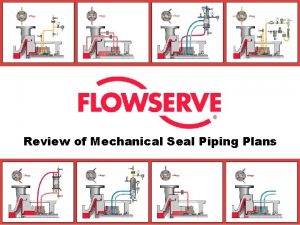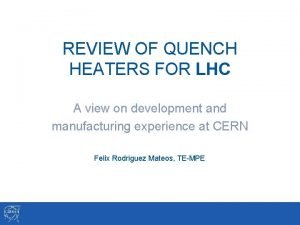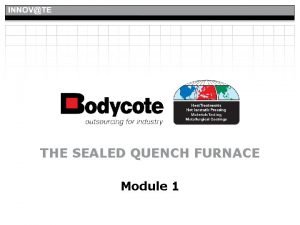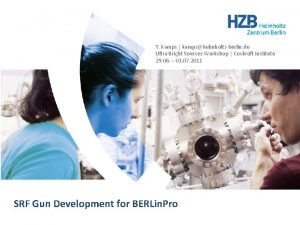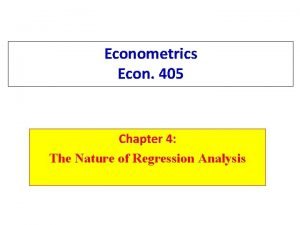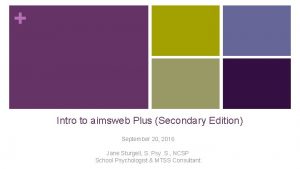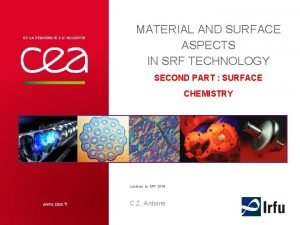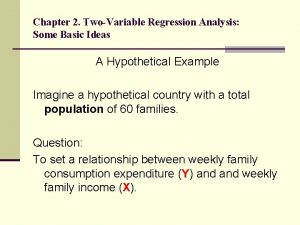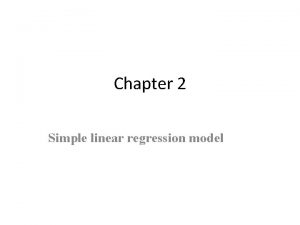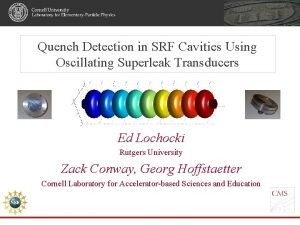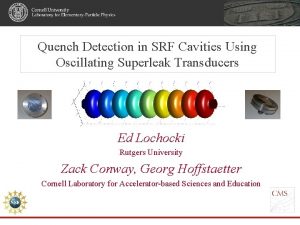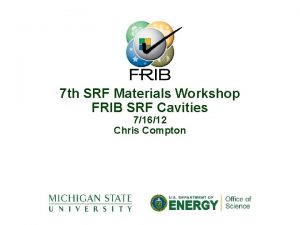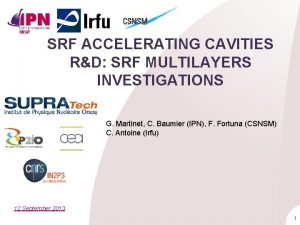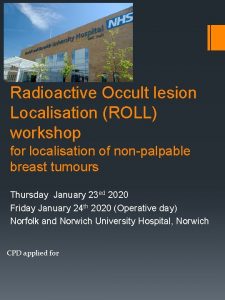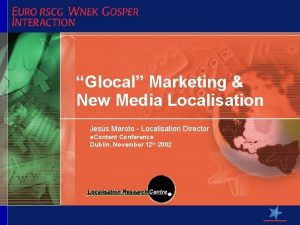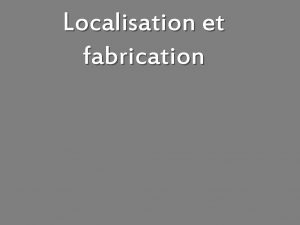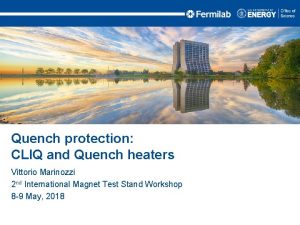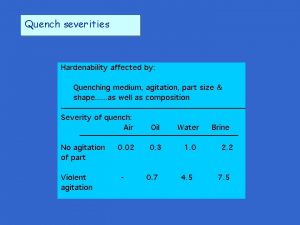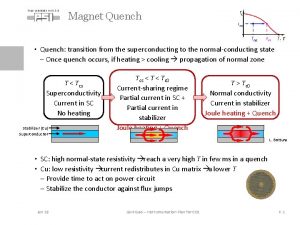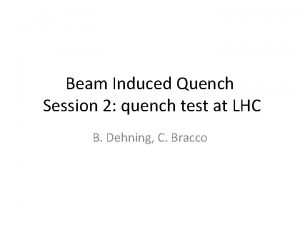Thermal mapping of SRF cavities for quench localisation












- Slides: 12

Thermal mapping of SRF cavities for quench localisation Lorena VEGA CID Section: BE/RF/SRF Supervisors: Giovanna Vandoni and Torsten Koettig 10 th May 2019 FTEC Workshop VII 1

Index Overview of SRF Cavities 2. Motivation for thermal mapping 3. Tasks and progress 1. 10 th May 2019 FTEC Workshop VII 2

1. 1. SRF cavities: Operating principle p+ Simulation of changing E-field Courtesy: P. Zhang simulation tesla style cavity 10 th May 2019 FTEC Workshop VII

1. 2. SRF Cavities: Superconductivity Ø Superconductivity given by niobium: Temperature along the wall thickness must be well below the transition temperature (9. 2 K)! Ø Two types of cavities are used at CERN: Power= 1000 W/m 2 HTC (He interface)= 3000 W/m 2 K (Kapitza approximation) He temperature=2 K Copper with thin film niobium Bulk niobium Power Niobium Copper Helium interface at 2 K ₓ *Simulation parameters: ü Reliable operation with vast experience, Bulk Nb: produced in industry. ₓ High cooling power required to maintain the wall in SC regime. 10 th May 2019 Helium interface at 2 K ü Improved cooling thanks to the high thermal diffusivity of copper. ₓ Performance degradation at high fields: Cause not well understood, potentially due to defects in thin film. FTEC Workshop VII 4

1. 3. SRF cavities: Test the performance Test in SM 18 - Evaluate the performance of the cavities. - Obtain quality parameters. - Detect presence of defects by quench localisation. 10 th May 2019 FTEC Workshop VII 5

2. Motivation for thermal mapping Quench localization • Defects not always visible by optical inspection. • Temperature map of the cavity helps to detect where the quench has initiated. Contact thermometry • Based on temperature sensors in contact with the cavity walls Non contact thermometry • Based on detection of second sound in superfluid helium 10 th May 2019 FTEC Workshop VII 6

2. 1. Motivation for thermal mapping: Quench localization in superfluid Helium He. II He. I Courtesy: H. Furci, G. Vandoni • • Second sound is a temperature wave that propagates ONLY in superfluid helium (T<2. 17 K). Possibility of localizing hot spots that initiate the temperature wave by trilateration. 10 th May 2019 FTEC Workshop VII 7

2. 2. Motivation for thermal mapping: Quench localization in superfluid Helium at CERN • Sensors: Currently two types of sensors used at CERN for second sound detection: TES (Transition Edge Sensors) OST (Oscillating Superleak Transducers) Resistance variation due to transition from SC to NC Relative movement of membrane due to variation of superfluid to normal-fluid component in He II. OST • Target: Cavities tested with He II ü Bulk Nb cavities: always ü Nb/Cu cavities: for R&D purposes 10 th May 2019 FTEC Workshop VII 8

3. 1. Tasks and progress. Part 1: Instrumentation of cavities for second sound detection: Instrumentation 1. i. ii. iv. Select best TES “recipes” (35 recipes/138 calibrated): Done Calibrate TES: To be done Re-design TES supports for adapting to different cavities: Ongoing Improve the cabling: Ongoing Data acquisition 2. i. ii. Familiarization with RF terminology and Lab. View interface for data acquisition: Done Debug and consolidate the present DAQ: Ongoing Post-processing of data 3. i. ii. Understand adapt the Matlab codes for data analysis: Done User friendly interface: To be done 10 th May 2019 FTEC Workshop VII 9

3. 2. Tasks and progress. Part 2: R&D Quench localisation in Nb/Cu cavities Ø Can we localize a point where the quench is initiated in Nb/Cu cavities? Niobium thin film Copper High thermal diffusivity in copper: High spread of temperature! • Model hot spot diffusion with finite element analysis: Dimension of defect causing hot spot stabilization/propagation? Nb/Cu interface: Thermal resistance? Creation of model: Done Cu/He interface: Heat transfer regime? Ø • Definition of material properties: Done Definition of boundary conditions: Ongoing Generated heat during quench? If so, which method? (No second sound in He. I!): Literature review: Ongoing o Thermal mapping with contact thermometry (rotatable/stationary): Well-known systems. Previous experience at CERN. o First sound detection? : To be investigated…. 10 th May 2019 FTEC Workshop VII 10

Thanks for your attention. Any questions? 10 th May 2019 FTEC Workshop VII 11

Second sound in superfluid helium Oscillation of normal and super-fluid in counterflow. No density waves driven by pressure difference but thermal excitation (entropy) waves, driven by temperature difference. Powerful mechanism of heat transfer – non diffusive – leading to high thermal conductivity ~20 m/s at 1. 8 K 10 th May 2019 R. Donnelly. Physics today 2009 FTEC Workshop VII 12
